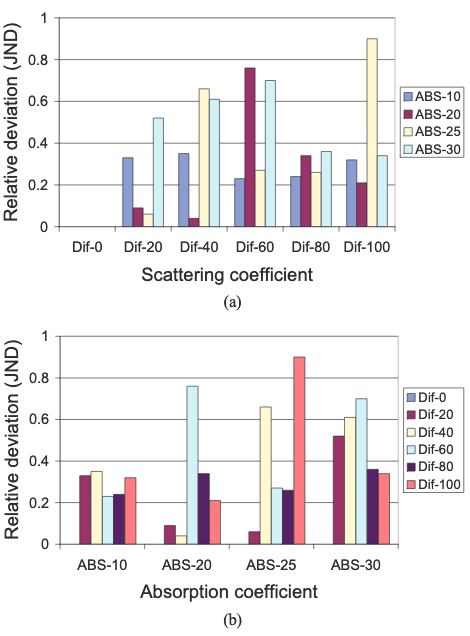On absorption and scattering coeficient effects in modellisation software
Acoustics Australia. Vol. 41 Num. 2 pp 151-155. Agosto 2013. ISSN 0814-9039.
S. Cerdá, R. Lacatis and A. Giménez
http://www.acoustics.asn.au/journal/Vol41No2LowRes.pdf
Introduction
 The modelling of a room, hall, or concert hall by an acoustic simulation program involves two main processes: firstly, the development of a geometric model using a set of surfaces; and secondly, the allocation of a material for each of the surfaces. The most recent programs indicate absorption and scattering coefficients in frequency bands. The scattering coefficients are interpreted as the percentage of energy not specularly reflected. Energy conservation is given by the relationship
The modelling of a room, hall, or concert hall by an acoustic simulation program involves two main processes: firstly, the development of a geometric model using a set of surfaces; and secondly, the allocation of a material for each of the surfaces. The most recent programs indicate absorption and scattering coefficients in frequency bands. The scattering coefficients are interpreted as the percentage of energy not specularly reflected. Energy conservation is given by the relationship
(1 – s)(1 – α) + α + s(1 – α) = 1
where s is a scattering coefficient (the fraction of reflected energy that is not reflected specularly); and α is an absorption coefficient (the fraction of incident energy that is not reflected). The programs that include scattering give reliable results, as was remarked in the First International Round Robin on Room Acoustical Computer Simulations. The use of scattering coefficients in simulation programs is a simple way to make these programs realistic. The coefficients can also serve as a tool that enable users to adjust their model to the experimental data.
Two commercial programs were used in this study: CATT-Acoustic v.8 with The Universal Cone Tracer (TUCT); and Odeon v10. Although both programs are based on ray tracing, the scattering treatments differ in each program.CATT-Acoustic uses cone-tracing algorithms.
Accordingly, scattering is frequency dependent; while direct sound and first-order specular reflection are deterministic. From the second reflection, specular and diffuse reflection is performed randomly. Thus for the coefficient s = 0.5 (in CATT-Acoustic a number between 0 and 100 is used, while in Odeon a number between 0 and 1 is used), half of the rays are specularly reflected and the other half are diffused.
Odeon uses a hybrid algorithm. For early reflections it uses the mixed method of images and ray tracing. For late reflections it uses a special ray tracing method, with secondary sources that radiate energy from the wall surfaces. The parameter transition order (TO) (default 2) defines the transition from early to late reflection methods. The program also specifies the number of rays included in the early reflection method.
For reflections with an order that is lower than the transition order (TO), Odeon determines the source image and includes the corresponding reflection in the reflectogram (if visible to the source). The attenuation of that reflection is determined while taking into account distance, scattering, and air absorption. Odeon continues with the mixed method until the TO order. The late-rays are treated as secondary sources and emit a diffracted beam in accordance with the Lambert distribution. The result is the sum of the two beams with the weights ‘1-s’ and ‘s’.
In brief, the difference between the two programs is in the first and second order reflections (TO by default). In the CATT case (Algorithm 1) the first order reflections are treated stochastically, whereas Odeon uses the mixed method of image and ray tracing.
